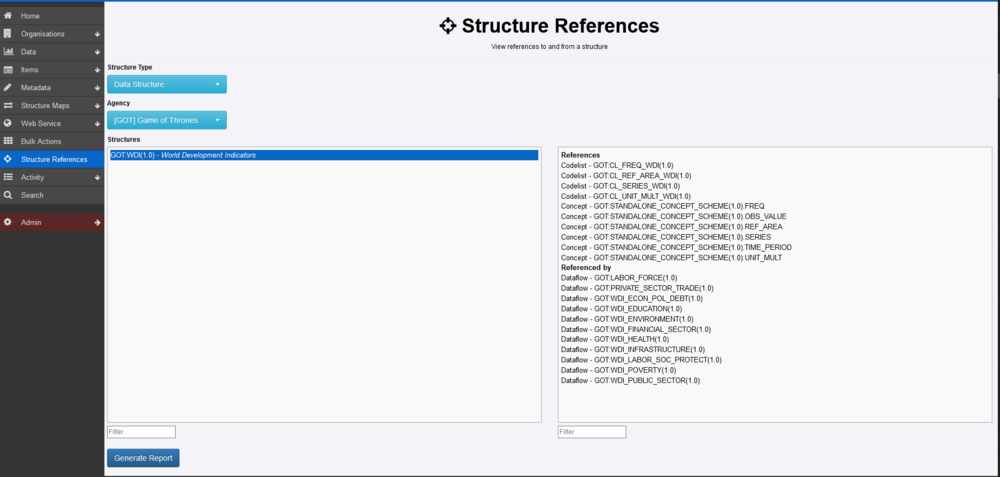Difference between revisions of "Structural Usage - Structure References"
| Line 1: | Line 1: | ||
__NOTOC__ | __NOTOC__ | ||
[[Category:Structural Metadata]] | [[Category:Structural Metadata]] | ||
| + | [[Category:SDMX Structures]] | ||
== Overview == | == Overview == | ||
Revision as of 02:35, 8 August 2023
Overview
The Registry provides the ability to see how structures relate to each other. On an individual structure pages, selecting an item in the table shows information about that structure beneath it. For example, on the Data Structure Definitions page, selecting an individual Data Structure shows which Structures are Cross Referenced by it and also the number of Dataflows that reference this DSD.
Fusion Registry also provides a dedicated page to explore the relationships between structures. This Structure References page allows the navigation from one structure to any of its dependencies.
Use the two drop-downs on the page to select the type of structure to view and optionally filter by agency. A list of structures matching those selections will be displayed in the list on the left. Selecting an item in the list shows the Structures that Reference it and those Structures that are referenced by it.
Figure 1 showing the Structure References page and the references to and from a DSD
Clicking on a structure displayed in the list on the right, will display that structure in the list on the left. The structures referencing and referenced by this structure will of course be displayed in the list on the right. By clicking on the items on the right hand side, the user can navigate around the structures, observing the relationships between them.
This page also provides the ability to generate reports about all of the structures in the system. There are currently 2 reports that can be generated.
All Structures Cross-Reference Report
This report has 3 worksheets. The first worksheet (titled “Overview”) lists all of the Structures in the Registry that have references and for each structure lists the count of how many structures it references (the “Reference Count”) and how many structures are referenced by it (the “Referenced By Count”). For a structure such as a DSD you would expect a high number for the “Reference Count” (as it probably references a number of Concepts) and a low number for the “Referenced By Count” (only Constraints and Dataflows may reference a DSD). A Codelist will always have zero for the “Reference Count” as it does not reference any other structures. From this worksheet the popularity of particular structures can be observed.
The second worksheet (titled “Consolidated”) lists all of the Maintinables in the system that reference another Maintainable and explicitly states what that reference is. A single row only shows a single relationship, so if a single Maintainable references a number of items (e.g. a DataStructure references a number of ConceptSchemes) then this Maintainable is repeated with each relationship stated on a different row.
The third worksheet (titled “Granular”) is very similar to the second worksheet, but shows the relationships at the Identifiable level. E.g. a Dimension might reference a Codfelist and a Concept. A single row only shows a single relationship, so if a single Identifiable references a number of items, that identifiable is repeated on a number of rows against the different references. From this worksheet the actual relationships can be observed. Since this worksheet is likely to be long, there are filters on the first row to aid in identifying the structures you may be interested in.
Structures with no Cross-References Report
This is a single worksheet report which lists Maintainables that are not cross-referenced and do not cross-reference any other structure. From this report it is easy to see which structures in the Registry are not used and are candidates for deletion.
